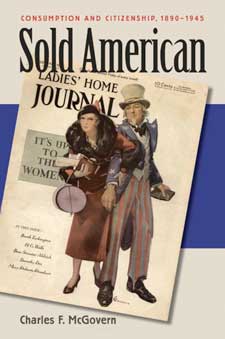
Book Review
Sold American: Consumption and Citizenship, 1890-1945
Chapel Hill: University of North Carolina Press, 2006
xv + 536 pages. Notes, index, bibliographic references, and illustrations
$24.95 (paper) ISBN: 0-8078-5676-2
In Sold American, Charles McGovern examines the rise of consumer culture in the United States from the Gilded Age through World War II. McGovern addresses the role of advertising as well as that of consumer protection groups. In detail, he explains how Americans came to equate Americanism and patriotism with consumerism.
The necessary precondition for a consumer culture is a populace convinced to abandon the old habits of thrift, the belief in products both durable and enduring. That abandonment occurred in the period between 1890 and 1930. In explaining how and why the change took place, McGovern tracks the rise of advertising, the advent of name brands, and the switch from local and regional loyalties to national brands. He also shows how an overwhelming array of goods with no discernible differences creates a consumer class totally lost about what value really is. The bewildered consuming masses are easy prey for companies that are no longer their own advertisers, but rather rely on professionals equipped with the latest techniques of persuasion. When every variant is pretty much the same, image—a compelling back story—provides a means of distinguishing one from the other. The ad men willingly draw the distinctions, tie a product to a nationalistic or domestic story; the manufacturers gladly put on a price tag to match. Even today, advertising relies on the back story rather than the merits of the product--and many consumers make their choices by reaching from a sea of sameness for the life preserver of a higher price tag.
While advertising altered local Americans, changing them into national consumers, progressive emphases on professionalism and science/technology were creating an ideal consumer of a different sort. This consumer eschewed the lies and distortions of the snake-oil salesmen. Rather, the goal of the informed consumer was on purchasing products based on specific knowledge and clear understanding of distinctions and relative worth of products. Part of this effort was scientific purchasing. The long-term impact was the rise of consumerism—particularly Consumer Research.
Consumer Research attempted to rise above brand names. It tested various models and published reports on what the best of a given item should have in it. It ignored brand ratings, expecting the informed consumer to examine labels (where labels had the information) and identify on their own the one best matching the highest rated item. Consumer Research failed as a mass manipulator, but its founder had no aspirations to being the counterforce to the ad men.
McGovern deals at length with the rise of Consumer Research, its relations with government and advertising men, and its attitude toward consumers. He finds that the scientists at Consumer Research were similar to the ad men on Madison Avenue.
McGovern says that ad men regarded themselves as a class apart from those they sold their bills of goods and unrealizable dreams. He also shows the contempt that ad men initially held for the consumer. Like the Enron executives embarrassed by e-mails highly insulting to energy consumers in California, ad men for BBD&O were often blunt in their assessments of the average consumer’s competence and tastes.
On the other side were the consumer advocacy groups. Fighting to retain a historical, perhaps mythical, American devotion to quality, these groups sought to protect consumers from shoddy and fraudulently represented goods. They saw themselves as adversaries of the ad men. Yet while they regarded the consumer as being in need of protection, they also saw themselves as members of a superior class to the consumer.
When the Great Depression undid the smugness of the ad men and brought them closer to the consumers, both ad men and advertising symbols changed. World War II also brought new symbols into being, selling the message that the route to victory was through consumption—a message that Americans had internalized by that point. The third three-chapter section of Sold American deals with the consumer culture as it begins the flowering that characterizes the second half of the twentieth century.
McGovern’s work builds on those of previous authors, but it is new in that it takes the subject as its single focus rather than a part of something else. Most important, McGovern shows how advertising manipulated symbols. The author provides abundant illustrations—representative advertisements from magazines show the manipulation of symbols as well as the change in message over time. He also discusses corporate personae such as Betty Crocker and Aunt Jemima. Additionally, he discusses the creation of personae for company founders and executives—the fictitious biographies of perhaps predatory businessmen, precursors in a sense to Walt Disney, Dave Thomas, Victor Kiam, and the many others who, in the latter portion of the twentieth century, became the advertising face of their businesses.
The story told here is not new, at least in its outline. McGovern’s accomplishment is providing a stand-alone study of the rise of consumerism, showing its competing forms and explaining the victory of the patriotic consumerism that the United States “enjoys” today. The work provides abundant detail, appropriate anecdote, and the full panoply of scholarly attire. It is a nice addition to the bookshelf of anyone interested in how the twentieth-century United States managed to move so far from what it was at the turn of the century.
McGovern has written the defining text on the internalization of consumerism. Now, we need a study of the differing consumerisms of racial and ethnic groups as well as immigrant generations. When that happens, may McGovern do the writing.

